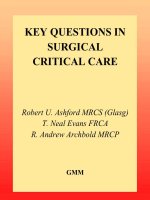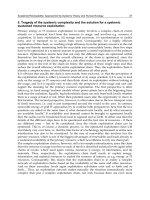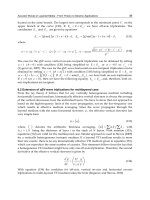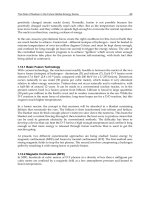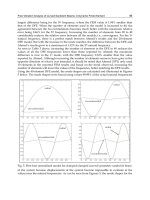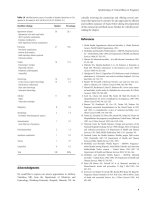KEY QUESTIONS IN SURGICAL CRITICAL CARE - PART 3 doc
Bạn đang xem bản rút gọn của tài liệu. Xem và tải ngay bản đầy đủ của tài liệu tại đây (73.85 KB, 25 trang )
Key Questions in Surgical Critical Care
36
MCQs
1. The following are indicators of a severe attack acute
pancreatitis:
A. Plasma calcium Ͼ 2.6 mmol/l
B. Arterial pO
2
Ͻ 8 kPa
C. Amylase Ͼ three times upper limit of laboratory norm
D. Blood glucose Ͼ 8 mmol/l
E. White cell count (WCC) Ͼ 15 ϫ 10
9
/l
2. The following are factors which increase risk of rebleeding
following a gastrointestinal haemorrhage:
A. Malignancy
B. Acute rather than chronic ulcer
C. Shock on admission
D. Age Ͻ 60 years
E. Gastric ulcer
3. Concerning severe pancreatitis:
A. Hypocalcaemia is the most common metabolic problem
B. Coagulopathy is usually the first organ system failure to
manifest itself
C. Failure of two organ systems is associated with 90% mortality
D. Solid, infected pancreatic necrosis will often respond to
intravenous antibiotics
E. Positive end expiratory pressure (PEEP) may be useful in
managing respiratory failure
4. Concerning acute renal failure (ARF):
A. Ultrasound should be performed early
B. Supravesical obstruction is common
C. Insertion of a double J stent is the preferred treatment of
supravesical obstruction
Q
Q
Q
Q
Other Systems and
Multisystem Failure
Questions
Kqs-Q-s1-3.qxd 5/11/02 11:22 AM Page 36
D. A unilateral dilated collecting duct system requires urgent
decompression and subsequent renography
E. For pelvic malignancy causing ARF nephrostomy insertion is
the treatment of choice
5. Concerning thoracic trauma:
A. Chest trauma is responsible for approximately 25% of trauma
deaths
B. Most patients with chest injuries ultimately require
thoracotomy
C. Penetrating chest wounds often require formal surgery
utilising cardiopulmonary bypass
D. Massive haemothorax is defined as Ͼ750 ml blood in the
chest cavity
E. Continuing blood loss of Ͼ50 ml/h is an indication for
thoracotomy
6. Characteristic injuries of blunt thoracic trauma include:
A. Fractured sternum
B. Transected aorta
C. Pulmonary contusion
D. Ruptured spleen
E. Bilateral rib fractures
7. Causes of hypoxia in thoracic trauma include:
A. Blood loss
B. Cardiac tamponade
C. Pulmonary contusion
D. Ventilatory failure
E. Mediastinal disruption
8. The following drugs require dose alteration in renal
failure:
A. Paracetamol
B. Heparin
C. Morphine
D. Ranitidine
E. Metoclopramide
Q
Q
Q
Q
Key Questions in Surgical Critical Care
37
MCQs
Other Systems and Multisystem Failure Questions
Kqs-Q-s1-3.qxd 5/11/02 11:22 AM Page 37
9. Subdural haematoma (SDH):
A. Is associated with a 20% mortality in cases of simple SDH
B. Following decompression, management is aimed at
decreasing cerebral swelling
C. Multiple SDH is associated with a mortality as high
as 90%
D. Is due to the tearing of bridging vessels
E. Is classically associated with a lucid interval
10. Concerning shock after a spinal injury:
A. Absent reflexes suggest spinal shock
B. Hypotension and tachycardia suggest neurogenic shock
C. Tachycardia and flaccid muscle is common in spinal
shock
D. Bradycardia is a feature of spinal shock
E. Vasopressors may be required in neurogenic shock
11. Concerning smoke inhalation injuries:
A. The half life of carboxyhaemoglobin (COHb) breathing 100%
oxygen is less than 1 h
B. High flow oxygen should be given until the COHb level is less
than 5%
C. Smoke inhalation causes thermal damage to the whole
respiratory tract
D. Soot in the mouth is an indication for fibre-optic
laryngoscopy
E. Intubation should be avoided
12. Gastrointestinal stress ulceration:
A. Is rare
B. Causes significant bleeds in 5% of cases
C. Has a mortality which is influenced by prophylaxis
D. Can be prevented by the use on H
2
antagonists in all critically
ill patients
E. Often necessitates surgical intervention
Q
Q
Q
Q
Key Questions in Surgical Critical Care
38
MCQs
Other Systems and Multisystem Failure
Questions
Kqs-Q-s1-3.qxd 5/11/02 11:22 AM Page 38
13. Enteral nutrition is contra-indicated in the following
circumstances in the critically ill patient:
A. Small bowel obstruction
B. Inflammatory bowel disease
C. Dysphagia
D. Small bowel fistulae
E. Diarrhoea
14. The following are necessary daily for patients on total
parenteral nutrition (TPN):
A. Full blood count (FBC)
B. Albumin
C. Calcium
D. Urea
E. Glucose
15. Concerning clinical evaluation of pelvic injuries:
A. Rectal examination is often unnecessary
B. The patient should have a urethral catheter inserted in all
cases to monitor urine output
C. Antero-posterior (AP) compression injuries are usually more
severe than lateral compression injuries
D. Pelvic stabilisation is the first priority
E. Unstable pelvic ring fractures are associated with a high
mortality
16. Concerning thermal regulation:
A. Hyperthermia is defined as a body temperature
above 39ЊC
B. Respiratory acidosis occurs with hyperthermia
C. Malignant hyperpyrexia is related to the use of volatile
anaesthetic agents
D. The nervous system is most often affected in
hyperthermia
E. Central lines should be changed at 5 day intervals
Q
Q
Q
Q
Key Questions in Surgical Critical Care
39
MCQs
Other Systems and Multisystem Failure Questions
Kqs-Q-s1-3.qxd 5/11/02 11:22 AM Page 39
Key Questions in Surgical Critical Care
40
MCQs
Other Systems and Multisystem Failure
Questions
17. Anastamotic leakage:
A. Is uncommon
B. Has a higher incidence in shocked patients
C. When suspected merits an early 2nd look procedure
D. There is no role for CT scanning
E. Early nutritional support is advisable
18. Concerning the cephalosporins:
A. Cefuroxime is a 3rd generation cephalosporin
B. Approximately 25% of patients with penicillin
hypersensitivity are also hypersensitive to the
cephalosporins
C. They have variable intestinal absorption
D. They are generally metabolised in the liver
E. 3rd generation cephalosporins are less active against
gram-positive organisms than 2nd generation
19. The following criteria allow for non-operative
management of liver injuries:
A. Haemodynamically stable patient
B. Persistent abdominal pain
C. Blood transfusion requirement of 2 units
D. Intra-hepatic haematoma on CT scan
E. Haemoperitoneum Ͻ1 l on CT scan
20. The following are indications for laparotomy in
abdominal trauma:
A. Peritonitis
B. Persistent shock
C. Evisceration
D. Uncontrolled haemorrhage
E. Gunshot wounds
21. The following are recognised post-operative complications
following hepato-biliary surgery for trauma:
A. Rebleeding
B. Bile leaks usually requiring further surgery
C. Ischaemic segments
Q
Q
Q
Q
Q
Kqs-Q-s1-3.qxd 5/11/02 11:22 AM Page 40
D. Subhepatic sepsis in approximately 20% of cases
E. Infected fluid collections rarely
22. Concerning mortality after liver injury:
A. The overall mortality is approximately 25%
B. Penetrating injury carries a mortality of 15–20%
C. Blunt injury has a lower mortality than penetrating injury
D. Mortality of blunt hepatic injury is approximately 10% if
only the liver is injured
E. Bleeding causes the majority of deaths
23. Blunt trauma to the pancreas:
A. May be clinically occult
B. Abdominal radiographs may show retroperitoneal air
C. Endoscopic retrograde cholangio-pancreatogram (ERCP) is
the best investigation
D. Serum amylase is a good investigation
E. Duct damage may be missed at laparotomy
24. The following complications are associated with
pancreatic trauma:
A. Pseudocyst
B. Pancreatic fistula
C. Ascites
D. Pancreatic abscess
E. Acute pancreatitis
25. The post-operative hepatic transplant patient:
A. Should resume enteral feeding as soon as possible
B. Steroids are usually continued for at least 1 year
C. Liver function tests (LFTs) are performed daily
D. Cyclosporin is often given in combination with azathioprine
as immunosuppressive
E. Acute rejection occurs in approximately half the patients
26. The following are contra-indications to liver
transplantation:
A. Hepatocellular carcinoma
B. Extrahepatic malignancy
Q
Q
Q
Q
Q
Key Questions in Surgical Critical Care
41
MCQs
Other Systems and Multisystem Failure Questions
Kqs-Q-s1-3.qxd 5/11/02 11:22 AM Page 41
C. Systemic sepsis
D. Liver metastases from sarcomata
E. Cardiopulmonary disease
27. Acute renal failure:
A. Carries a mortality of approximately 10%
B. Oliguria in an adult is defined as a urine output less than
400 ml per day
C. Mortality increases to 70% if one other organ system is
involved
D. Sequelae include hypercalcaemia and hypokalaemia
E. May lead to pericarditis
28. The following may cause post-operative hepatic
dysfunction:
A. Sepsis
B. Pancreatitis
C. Transfusion
D. Hypoxia
E. Surgery
29. The following are major inflammatory mediators in
systemic inflammatory response syndrome (SIRS):
A. Platelet activating factor (PAF)
B. Tumour necrosis factor (TNF) 
C. Interleukin 1
D. Interleukin 8
E. Interleukin 5
30. The following endocrine responses occur after major
trauma:
A. Increased prolactin
B. Decreased anti-diuretic hormone (ADH)
C. Increased thyroxine
D. Increased catecholamines
E. Increased cortisol
Q
Q
Q
Q
Key Questions in Surgical Critical Care
42
MCQs
Other Systems and Multisystem Failure
Questions
Kqs-Q-s1-3.qxd 5/11/02 11:22 AM Page 42
31. In patients with renal failure, dose modification may be
necessary with the following antibiotics:
A. Ampicillin
B. Cefuroxime
C. Benzyl penicillin
D. Gentamicin
E. Metronidazole
32. Regarding head injury:
A. The mortality associated with an acute subdural haematoma
is approximately double that of acute epidural haematoma
B. Skull fracture is associated with a 20-fold increase in
incidence of extradural haematoma
C. Patients with acute subdural haematoma may have a lucid
interval
D. Rapid deceleration injuries are associated with subdural
haematoma
E. Contrecoup injuries are often more serious than coup injuries
33. The following are radiological signs of major thoracic
trauma:
A. Mediastinal widening
B. Fractured 2nd rib
C. Fractured sternum
D. Mediastinal emphysema
E. Loss of aortic definition
34. Concerning enteral nutrition in the ICU patient:
A. Where intra-cranial pressure (ICP) is elevated sodium
restricted feeds are appropriate
B. High volume energy dense feeds are used for patients with
severe burns
C. Glutamine supplementation is essential to prevent skeletal
muscle catabolism
D. A typical 2000 ml feed would provide approximately 35 g
protein
E. 100 ml of standard polymeric enteral feed provides
approximately 100 kcal energy
Q
Q
Q
Q
Key Questions in Surgical Critical Care
43
MCQs
Other Systems and Multisystem Failure Questions
Kqs-Q-s1-3.qxd 5/11/02 11:22 AM Page 43
35. The following are complications of enteral nutrition:
A. Aspiration
B. Hypoglycaemia
C. Hypercapnia
D. Fluid overload
E. Infection
36. Concerning ballistic thoracic injuries:
A. Witnessed cardiac arrest is an indication for resuscitative
thoracotomy
B. Pneumothorax is the commonest injury
C. 80% of patients with a haemothorax can be treated with
tube thoracostomy alone
D. Pericardiocentesis is of limited value
E. Exploratory thoracotomy is the treatment of choice for
transmediastinal injuries
37. Concerning head injuries:
A. Epidural haematoma classically present with a lucid interval
B. Acute SDH have a better prognosis than epidural haematoma
C. Maintenance of cerebral perfusion pressure (CPP) is essential
in their management
D. ICP is normally 15–25 mmHg in an adult
E. CPP should be maintained above 60 mmHg
38. Treatment of raised ICP includes:
A. CSF drainage
B. Prophylactic hyperventilation
C. Intravenous 20% mannitol
D. Sedation
E. Hypothermia
39. The following monitoring is necessary in cases of acute
cervical spinal cord injury:
A. Arterial blood pressure
B. Pulmonary artery occlusion pressure
C. End-tidal CO
2
Q
Q
Q
Q
Q
Key Questions in Surgical Critical Care
44
MCQs
Other Systems and Multisystem Failure
Questions
Kqs-Q-s1-3.qxd 5/11/02 11:22 AM Page 44
D. Pulse oximetry
E. Urinary output
40. Burns:
A. Mortality associated with a concomitant inhalation injury is
30% greater than that without inhalate injury
B. Inhalation injury commonly results in hypoxaemia associated
with bronchospasm and bronchorrhoea
C. Burn wound sepsis is the leading cause of death
D. The hypermetabolic response to burn injury peaks
at 48 h
E. Burns patients suffer a marked protein catabolism
41. The following are indications for surgery in acute
pancreatitis:
A. Positive fine needle aspirate
B. Sepsis
C. Peritonitis
D. Failure to respond to ICU therapy
E. Respiratory insufficiency
42. The following are suggestive of pre-renal renal failure:
A. Urine sodium Ͻ 20 mmol/l
B. Urine osmolality Ͼ 500 mosm/kg H
2
O
C. Fractional excretion of sodium Ͼ 1%
D. Urine creatinine/plasma creatinine Ͻ 20
E. Muddy brown granular casts
43. Fluid balance:
A. A 70 kg man has approximately 28 l fluid in the interstitial
compartment
B. Approximately 95% potassium is extracellular
C. The daily requirement of sodium is 1–2 mmol/kg/day
D. Hartmann’s solution is preferred to normal saline in patients
with renal failure
E. The stress response to surgery leads to sodium retention
Q
Q
Q
Q
Key Questions in Surgical Critical Care
45
MCQs
Other Systems and Multisystem Failure Questions
Kqs-Q-s1-3.qxd 5/11/02 11:22 AM Page 45
Key Questions in Surgical Critical Care
46
MCQs
Other Systems and Multisystem Failure
Questions
44. Fat embolism:
A. Leads to the fat embolism syndrome (FES) in 20%
of cases
B. Is frequently seen in patients with acute pancreatitis
C. Occurs in association with reaming of long bones
D. Necessitates heparinisation
E. Requires management by ventilation
45. Characteristics of the FES include:
A. Pulmonary insufficiency
B. Thrombocytosis
C. Conjunctival haemorrhages
D. Petechial rash
E. Cerebral signs
46. Causes of hypoxia in thoracic trauma include:
A. Blood loss
B. Tamponade
C. Pulmonary contusion
D. Ventilatory failure
E. Mediastinal disruption
47. Clearance of the following drugs is reduced in ICU
patients with hepatic dysfunction:
A. Midazolam
B. Fentanyl
C. Diazepam
D. Thiopentone
E. Furosemide (frusemide)
48. The following are risk factors for the development of
acute tubular necrosis (ATN):
A. Diabetes mellitus
B. Infection
C. Malnutrition
D. Hypovolaemia
E. Increasing age
Q
Q
Q
Q
Q
Kqs-Q-s1-3.qxd 5/11/02 11:22 AM Page 46
49. The following drugs may cause ARF:
A. Cephalosporins
B. Morphine
C. Dextran
D. Cotrimoxazole
E. Benzyl penicillin
50. The following would be indications to transfer a patient
to a burns centre:
A. Chemical burns
B. 15% 2nd degree burns in a patient aged 60
C. 10% burns in an 8 year old boy
D. An electrical burn with an entry wound on the finger and the
patient unable to flex the finger
E. 10% 3rd degree burns to the chest in a 25 year old
51. Lactic acidosis:
A. Is characterised by a normal anion gap
B. Is most commonly caused by poor tissue perfusion
C. May be caused by metformin
D. Impairs myocardial contractility
E. Should usually be treated by the administration of sodium
bicarbonate
52. Disseminated intravascular coagulation (DIC) is
characterised by:
A. Increased fibrinogen concentration
B. Increased fibrinogen degradation products
C. Prolonged activated partial thromboplastin time (APTT)
D. Thrombocythaemia
E. Fragmented red cells on blood film
53. DIC may be caused by:
A. Gram-negative septicaemia
B. Myocardial infarction
C. Burns
Q
Q
Q
Q
Q
Key Questions in Surgical Critical Care
47
MCQs
Other Systems and Multisystem Failure Questions
Kqs-Q-s1-3.qxd 5/11/02 11:22 AM Page 47
D. Pulmonary embolism
E. Haemolytic blood transfusion reactions
54. pH 7.27, pCO
2
3.7 kPa, pO
2
12.6 kPa, HCO
3
14 mmol/l, base
excess – 10 mmol/l (on air). These arterial blood gases are
characteristic of:
A. Respiratory acidosis
B. Respiratory failure
C. Acute renal failure
D. Septic shock
E. Lactic acidosis type A
55. pH 7.27, pCO
2
7.9 kPa, pO
2
7.1 kPa, HCO
3
24 mmol/l, base
excess 2 mmol/l (on air). These arterial blood gases are
characteristic of:
A. Type I respiratory failure
B. Chronic CO
2
retention
C. Opiate toxicity
D. Acute life-threatening asthma
E. Benzodiazepine overdose
56. SIRS:
A. May be precipitated by tumour invasion
B. May result from acute hypoxaemia post-operatively
C. Is less likely in burns victims since they have a reduced
immune response
D. Is due primarily to an abnormal immune reaction
E. Usually results in multi-organ dysfunction syndrome
(MODS)
57. SIRS may be diagnosed by:
A. Peripheral temperature Ͼ 38.5
o
C
B. Core temperature of 35.8
o
C
C. Tachycardia of 95 beats per minute
D. Respiratory alkalosis with a PaCO
2
of 4.2 kPa
E.
E. WCC of 3.9 x 10
9
/l (with 11% neutrophils)
Q
Q
Q
Q
Key Questions in Surgical Critical Care
48
MCQs
Other Systems and Multisystem Failure
Questions
Kqs-Q-s1-3.qxd 5/11/02 11:22 AM Page 48
58. SIRS:
A. Can occur without active injection
B. Results in cool peripheries due to systolic hypotension
C. Can result in respiratory acidosis due to hypoperfusion
D. The patient may have deranged clotting due to liver
hypoperfusion
E. Hypotension is exaccerbated by nitric oxide mediated
vasodilatation
59. Multi-organ dysfunction syndrome:
A. Is a direct effect of end-organ inflammation
B. Oliguria is a late sign suggesting that organ failure has
occurred
C. Gut hypoperfusion and mucosal atrophy is proposed to have
a role in propagating the inflammatory reaction
D. Is usually irreversible
E. In the lungs results in ARDS
60. Management of MODS:
A. Fluid therapy should be used sparingly since tissue oedema
and hypoperfusion may be worsened
B. Inotropes which increase afterload are avoided since they can
deteriorate myocardial function
C. There is no place for  agonists since they exacerbate
peripheral vasodilatation
D. Invasive measurement of cardiac output is mandatory to
guide treatment
E. Arterial cannulation is avoided because of the risk of distal
ischaemia
61. Prognosis in MOF:
A. Is improved in burns patients because they are treated in
specialist centres
B. Mortality rate is 95% on 4th day with three organs failed
C. Mortality rate is 20% on 1st day with two organs failed
D. Is worse at the extremes of age
E. Is improved in sepsis since the infecting precipitant may be
isolated, cultured and treated
Q
Q
Q
Q
Key Questions in Surgical Critical Care
49
MCQs
Other Systems and Multisystem Failure Questions
Kqs-Q-s1-3.qxd 5/11/02 11:22 AM Page 49
62. Electrolyte composition:
A. Intracellular K
+
concentration is normally Ͼ150 mmol/l
B. Ca
2+
is almost entirely extracellular
C. The daily requirement of Ca
2+
is 1 mmol/kg/day
D. Mg
2+
is mainly extracellular
E. Extracellular HCO
3
Ϫ
is three times as concentrated as
intracellular
63. The following statements concern crystalloid solutions:
A. 5% dextrose has a similar osmolality to blood
B. Hartmann’s solution has equal concentrations of Na
+
and Cl
Ϫ
C. Dextrose saline is distributed equally in intracellular fluid
(ICF) and extracellular fluid (ECF)
D. N/saline is hypertonic to blood
E. Hartmann’s solution is isotonic to blood
64. The following are appropriate replacement therapies for
the fluid loss:
A. Peritonitis and fresh frozen plasma (FFP)
B. Vomiting and D/saline
C. Diabetes mellitus and Hartmann’s solution
D. Diabetes insipidus and 5% dextrose
E. Burns and blood
65. Nutrition:
A. Body mass index (BMI) is weight
2
/height
B. Normal BMI is 22–28
C. Nitrogen requirement is usually 9 g/day for an adult male
D. Energy requirements are 10–20 kcal/kg for adult females per
day
E. In catabolic patients 1g nitrogen should be given for every
80–100 kcal energy
66. Nutrition in organ failure – the following are
appropriate:
A. Respiratory disease – low carbohydrate, high fat
B. Renal failure – low nitrogen, high fat
Q
Q
Q
Q
Q
Key Questions in Surgical Critical Care
50
MCQs
Other Systems and Multisystem Failure
Questions
Kqs-Q-s1-3.qxd 5/11/02 11:22 AM Page 50
C. Cardiac impairment – low sodium, high volume
D. Liver disease – low nitrogen, low carbohydrate
E. Cerebral impairment – low glucose
67. Nutrition – routes of feeding:
A. The parenteral route is favoured during acute phases of
illness on ICU since fluid balance is better controlled
B. Enteral feeding often requires the use of mucosal protection
such as sucralfate, since it is directly irritant to the gastric
lining
C. Enteral feeding increases the risk of nosocomial pneumonia
D. Hyperglycaemia is only associated with parenteral nutrition
in diabetic patients
E. Bowel sounds are a good predictor of gut function
68. Nutrition – physiology:
A. Fats and carbohydrates are completely oxidised to CO
2
and
water in the body
B. Protein usually makes up less than 20% of dietary intake
C. A high protein diet increases metabolic rate
D. Respiratory quotient (RQ) for fat is higher than carbohydrate
E. Protein consumption has a significant effect on the overall
RQ value
Q
Q
Key Questions in Surgical Critical Care
51
MCQs
Other Systems and Multisystem Failure Questions
Kqs-Q-s1-3.qxd 5/11/02 11:22 AM Page 51
Key Questions in Surgical Critical Care
52
MCQs
1. Concerning brainstem death (BSD):
A. Electroencephalogram (EEG) recording is necessary in the UK
to confirm BSD
B. 24 hours must elapse between the first and second set of
brainstem tests
C. The vestibulo-ocular reflex is tested by injecting 5 ml of
ice-cold water into each external auditory meatus
D. Apnoea is tested for by disconnecting from the ventilator
and insufflating with 6l/min oxygen until PaCO
2
Ͼ 6.65 kPa
E. Hypothermia is an exclusion criteria for BSD
2. Concerning post-operative surgical site infections:
A. Deep infections may occur more than 6 months after
implantation of a prosthesis
B. Clean wounds are associated with infection rates of
about 3%
C. The most common pathogen is Staphylococcus aureus
D. To reduce wound infections the operative site should be
shaved the night before surgery
E. Latex drains reduce the rate of infection following
abdominal surgery
3. Fat embolism:
A. Is more common after open than closed fractures
B. Leads to the fat embolism syndrome (FES) in 20% of
cases
C. Is commonly seen in patients with severe acute
pancreatitis
D. Occurs during the reaming process of intramedullary
nailing
E. Causes hypoxaemia and hypercarbia
Q
Q
Q
Problems in
Intensive Care
Questions
Kqs-Q-s1-4.qxd 5/11/02 11:23 AM Page 52
Key Questions in Surgical Critical Care
53
MCQs
Problems in Intensive Care Questions
4. Characteristics of the FES are:
A. Pulmonary insufficiency
B. Thrombocytosis
C. Conjunctival haemorrhages
D. Petechial rash
E. Cerebral signs
5. The following are normal paediatric vital signs:
A. Respiratory rate (RR) 40 in a 9 month old girl
B. Heart rate (HR) 120 in a 4 year old girl
C. Systolic BP 80 mmHg in a 7 year old boy
D. HR 60 in a 10 year old girl
E. Systolic BP 60 mmHg in a 2 year old boy
6. The following are required in the UK to confirm BSD:
A. Two consultants
B. EEG
C. Apnoea
D. Absent gag reflex
E. A minimum of 24 hours between the two sets of tests
7. The following are risk factors for nosocomial pneumonia:
A. Abdominal surgery
B. Antibiotic treatment
C. Intubation
D. Diabetes
E. Hypotension
8. The following organisms are likely to cause lung
infections in the intensive care unit (ICU) in the mentioned
circumstances:
A. S. aureus – head injury
B. Pseudomonas aeruginosa – prolonged ventilation
C. Anaerobes – head injury
D. S. aureus – thoracoabdominal surgery
E. Haemophilus influenzae – tracheotomy
Q
Q
Q
Q
Q
Kqs-Q-s1-4.qxd 5/11/02 11:23 AM Page 53
9. In septic shock, the following antibiotics are appropriate
for the suspected site of infection:
A. GI Tract – clindamycin
B. Surgical wound – vancomycin
C. Lung – piperacillin
D. Urinary tract – penicillin
E. Surgical wound – ceftazidime
Q
Key Questions in Surgical Critical Care
54
MCQs
Problems in Intensive Care
Questions
Kqs-Q-s1-4.qxd 5/11/02 11:23 AM Page 54
Key Questions in Surgical Critical Care
55
MCQs
1. The following score highly (2 or more) on the acute
physiology and chronic health evaluation (APACHE)
scoring system:
A. Temperature more than 39.2ЊC
B. Respiratory rate (RR) 24 breaths per minute
C. Heart rate (HR) 105 beats per minute
D. Potassium 5.4 mmol/l
E. Haematocrit 50%
2. Diamorphine:
A. Is highly lipid soluble
B. Can be given intrathecally
C. Is excreted primarily by the kidney
D. Has a half life of approximately 30 minutes
E. Is more likely than morphine to produce respiratory
depression
3. Epidural analgesia:
A. Epidural opioids are five times more potent than intravenous
B. Is associated with decreased respiratory complications
C. May cause cord compression
D. Urinary retention occurs in approximately 10%
E. Hypothesia should be treated with ephedrine and fluids
4. The following signs would alert a clinician to consider
critical care referral:
A. RR Ͼ 30 breaths per minute
B. Mean BP 180 mmHg, HR 100 beats per minute
C. Glasgow coma score (GCS) 7, Pulse 80, BP 130/80 mmHg
D. RR 8 breaths per minute, HR 50 beats per minute
E. Temperature 37.6ЊC, HR 110 beats per minute
Q
Q
Q
Q
Principles of
Intensive Care
Questions
Kqs-Q-s1-5.qxd 5/11/02 11:24 AM Page 55
Key Questions in Surgical Critical Care
56
MCQs
Principles of Intensive Care
Questions
5. The following factors have been shown to affect outcome
in intensive therapy unit (ITU) patients:
A. Increased age
B. Early diagnosis of the acute condition
C. Severity of the acute illness
D. Physiological reserve
E. Therapy
6. The following analgesics have the physiological effect
stated:
A. Alfentanil causes sedation
B. Morphine increases bile duct pressure
C. Fentanyl leads to histamine release
D. Fentanyl is an antitussive
E. Morphine increases splanchnic perfusion
7. Invasive haemodynamic monitoring may be associated
with the following complications:
A. Median nerve neuropathy
B. Very rarely intra-arterial thrombosis
C. Pneumothorax in 10% of central lines
D. Thoracic duct injury demanding surgical intervention
E. Pulmonary artery rupture, during insertion of a pulmonary
artery floatation catheter, with a mortality of 50%
8. Intensive care unit (ICU) scoring systems:
A. Hospital mortality rate is a useful guide to ICU
performance
B. Scoring systems, can be used to decide on optimal treatment
for individual patients
C. Risk adjustment is only usually necessary for multi-organ
pathology
D. Selection bias may occur due to incomplete validation
of data
E. Lead-time bias takes account of any treatment that the
patient has had before being admitted to ICU
Q
Q
Q
Q
Kqs-Q-s1-5.qxd 5/11/02 11:24 AM Page 56
Key Questions in Surgical Critical Care
57
MCQs
Principles of Intensive Care Questions
9. The revised trauma score (RTS):
A. Correlates well with risk of mortality
B. Scores 0–12 by a combination of GCS, mean blood pressure
(MBP) and oxygen saturation
C. A score of 12 correlates with over 90% mortality
D. A score of 6 correlates with a 63% survival
E. BP 80/50 mmHg scores 3
10. Scoring systems:
A. APACHE stands for adverse pathology and chronic health
evaluation
B. APACHE III is used to guide the most statistically successful
treatment
C. SAPS II stands for simplified acute physiology score and has
17 variables
D. APACHE II does not take mechanical ventilation into
account
E. APACHE II has more predictive power over individual patient
outcome than SAPS II
11. Injury severity scale (ISS):
A. The abbreviated injury score (AIS) is calculated by the sum of
the squares of the categories of the ISS
B. AIS lethal dose in 50% (LD 50) is age independent provided
patients have the same physiological reserve
C. ISS defines seven anatomical areas
D. In the ISS loss of consciousness for 12 minutes scores 3
E. In the ISS biliary tree injury scores higher than splenic
rupture
12. Sedative drugs:
A. Thiopentone is a suitable drug for general sedation in the
ICU
B. During propofol infusion, nutritional advice should be sought
regarding triphosphopyridine nucleotide (TPN) constitution
C. Etomidate causes muscle twitching
D. Ketamine may be used for rapid sequence induction
Q
Q
Q
Q
Kqs-Q-s1-5.qxd 5/11/02 11:24 AM Page 57
Key Questions in Surgical Critical Care
58
MCQs
Principles of Intensive Care
Questions
E. Midazolam is suitable for long term infusion since it is highly
water soluble and does not undergo significant hepatic
metabolism
13. Sedative drugs:
A. Propofol and etomidate cause pain on injection
B. Midazolam is the drug of choice for long term sedation since
it has a short duration of action
C. Ketamine causes hallucinations
D. Propofol has a duration of action of 2–3 minutes when given
by bolus
E. Etomidate does not work in one arm-brain circulation time
14. Analgesic drugs:
A. Morphine and fentanyl have similar elimination half lives
B. Morphine is longer acting than fentanyl
C. Fentanyl is more potent than alfentanil
D. Alfentanil has a longer duration of action than fentanyl
E. Morphine prevents, histamine release by mast cell
stabilisation
15. Opioids:
A. May cause chest wall stiffness leading to difficulty with
mechanical ventilation
B. Sedation but not pruritus is reversed by naloxone
C. Morphine 3 sulphate is an active metabolite
D. Morphine 6 sulphate is not an active metabolite
E. Cause hypotension by vasodilatation
16. Muscle relaxants:
A. Rocuronium is used for rapid intubation
B. Atracurium is a steroid and should not be used in renal
failure
C. Vecuronium may be used in liver failure
D. Vecuronium given as a bolus works within 60 seconds
E. Atracurium is broken down by Hoffmann degradation, which
is temperature dependent
Q
Q
Q
Q
Kqs-Q-s1-5.qxd 5/11/02 11:24 AM Page 58
Key Questions in Surgical Critical Care
59
MCQs
Principles of Intensive Care Questions
17. Suxamethonium:
A. Is structurally related to acetyl choline
B. Causes significant hypokalaemia in burns patients
C. Is metabolised in the liver
D. Causes myalgia
E. Decreases intra-optic pressure (IOP)
18. Physiology of body fluids:
A. Osmolality is the concentration of a solution expressed as
osmoles of solute per litre of solution (mosmol/l)
B. Osmolarity is measured by depression of freezing point
C. Toxicity is the osmotic pressure produced by osmotically
active particles at selective membranes
D. Semipermeable membranes allow solute but not solvent to
pass through
E. Osmolality of plasma is 290 mosmol/l
19. Renal physiology:
A. The kidney is involved in gluconeogenesis
B. Each kidney is made up of twelve thousand nephrons
C. Cortical nephrons have long loops of Henle which pass into
the inner medulla
D. Juxtamedullary nephrons account for less than 2% of
functional units and are primarily concerned with blood
pressure autoregulation
E. The outer medulla has the greatest blood flow reaching
625 ml/min during exercise
20. Renal physiology:
A. Glomerular filtration rate (GFR) is measured by the
Fick principle, using the substrate para-amino hippuric
acid (PAH)
B. Renal oxygen consumption is large leading to a low renal
venous oxygen content
C. The inner medulla is concerned with the countercurrent
exchange mechanism and hence has the greatest oxygen
consumption
Q
Q
Q
Q
Kqs-Q-s1-5.qxd 5/11/02 11:24 AM Page 59
D. The cortex utilises fatty acids in oxidative metabolism
E. The medulla utilises glucose in anaerobic metabolism
21. Renal physiology:
A. Renin is released from the macula densa in the proximal
convoluted tubule
B. Renin is a proteolytic enzyme exclusive to the kidney
C. Angiotensin I is an octapeptide
D. Angiotensin II exerts positive feedback on the adrenal cortex
E. Angiotensin II is active in the central nervous system (CNS)
22. Drugs and the kidney:
A. Systemic hypertension causes a diuresis
B. Carbonic anhydrase inhibitors cause a diuresis with low pH
and increased ammonia excretion
C. Loop diuretics inhibit Na
ϩ
Cl
Ϫ
co-transport in the descending
loop of Henle causing a large diuresis
D. Thiozide diureticis inhibit Ca
2ϩ
transport
E. Amiloride is an aldosterone antagonist which reduces K
ϩ
excretion in the distal convoluted tubule
Q
Q
Key Questions in Surgical Critical Care
60
MCQs
Principles of Intensive Care
Questions
Kqs-Q-s1-5.qxd 5/11/02 11:24 AM Page 60

